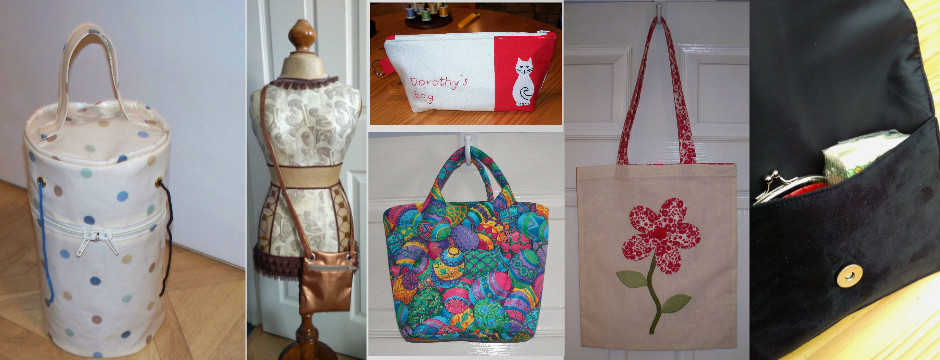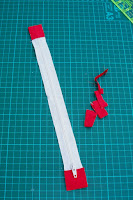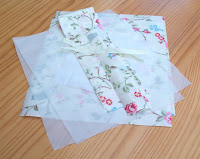I made this laptop sleeve for my Dad's recent
birthday. He had just bought his first
laptop and needed a case to keep it safe.
I wanted a fabric which would be quite masculine but also very
traditional, although not necessarily one that would commonly be used for a
laptop bag. I found this wool fabric in
amongst the tweeds and tartans at my local fabric store. It's soft and has muted colours - just what I
was looking for.
I used the same fabric on the outside and for the lining
which made the bag more expensive to make but it looked more professional and
it gave me lots of opportunities to match up the checks. When making this style
of bag where you join the lining to the outer fabric and then make the bag
shape, the lining always seems to be slightly visible (at least it is when I do
it), so that's another reason for using the same fabric inside and out. A plainer fabric such as a tweed would have
been easier to use because there would have been no need for matching the
design. However, I wanted a challenge!
The foam gives just the right amount of padding to
protect the laptop and the quilting reduces the bulk a little, stabilising the foam and helping the wallet to keep its shape.
This is essentially made in the style of a document
wallet. I made this all in one piece
which not only made it easier to make but is an adaptable style which could be
minimised to make a clutch bag. This
style wouldn't be suitable for a directional fabric because part of the pattern
would be the wrong way up. Thankfully, that wasn't a problem here.
It would have been easy to add a pocket internally or
externally but I didn't think it was necessary here.
As usual, I used ¼” seams throughout. When I was sewing through the foam, I have learnt
that a longer stitch length is needed for that level of thickness, so I
increased my stitch length to 3 for initially sewing the pieces together, quilting and top stitching and 3.5 for side
seams. I recommend experimenting with
your machine to find the smallest stitch length at which the machine can sew
through all the layers.
Skills
used in this project:
- Quilting
- Matching checks
- Fitting
- Keeping it simple
Step
1: Cutting out
Measure the dimensions of the laptop. These assume that
the laptop is approximately 1” deep.
Width = width across laptop
+ 2”
Length = top to bottom of
lid x2 + 6 ½”
I made this for a laptop
which measured 15” x 10” and was 1” deep.
I cut out fabric 17” x 26½”
If using a fabric which
needs matching (e.g. the checks in my fabric), carefully cut out both pieces so
that the pattern will match when joined right side to right side. The measurements might need a slight
adjustment to enable matching.
You will also need
13” Velcro
To create the shape in both pieces of fabric and the foam, at one
end I drew round a saucer to create the rounded shape of the flap. The image below shows the bag after the 2 pieces of fabric have been sewn together. The flap end is at the bottom of the picture.
At the other end, I started ½” in from the
side edge and made the rounded corners by drawing round part of a tape measure
for the cut out which was 1” deep and then cut straight across the fabric
between them.
Step
2: Joining the fabrics
Place the inner and outer fabric, right sides
together. Place the foam against the
wrong side of the outer fabric. Pin and
sew.
If relevant, match the pattern now as any mismatch will
be visible at the end.
I used a longer stitch than normal as the foam is quite
thick (3 – 3.5). Trim the foam as close to the seam line as you can without
cutting the stitches. This will make it
easier to sew the bag together later.
Leave a gap of about 5” along one of the long sides. Turn right sides out and hand sew the gap
closed.
Top stitch across the cut out end (not the flap end) to
hold the seam in place and create a professional finish.
Step
3: Quilting the bag
Pin around the side seams to ensure that the stitch line
remains sharp at the edge of the fabric and any matching pattern stays firmly
matching.
You need to decide whether you are quilting to add subtle
texture (use a matching thread which will be invisible) or quilting to create a
visual feature (use a contrasting thread which will be visible).
Using a walking foot if you have one, sew horizontal and
vertical lines approximately 2 ½” apart. I followed the lines woven into the
pattern of the fabric. Start by sewing the central vertical and horizontals and
then work outwards.
Step
4: Attaching the Velcro
Pin a strip of the velco centrally to one side of the
flap, ¾” from the top edge. Sew all round. This Velcro will be inside the flap when the bag is
assembled but the stitches will be visible on the front. If you don’t want them to show, consider
adding embellishments now to cover it e.g. a strip of ribbon, an embroidered
panel, appliqué, etc. It wasn’t necessary
with the fabric I chose as the stitches were barely visible because they blended in
with the quilting.
Pin the other strip of Velcro at the other end on the
opposite side of the fabric. When the
bag is made up, this will be on the outside. This needs to be ¾” from the cut
out edge. You should try folding the bag
into its final shape at this stage to make any small adjustments to where the
velcro should go to ensure that any fabric pattern is matched.
Step
5: Assembling the bag
Fold the end with cut out up by the height of the laptop
(in this case it was 10”), lining sides together. The Velcro should be on the outside. Pin both sides. At this stage, make sure that
you match the pattern at the sides and top so that the opening matches the
pattern of the inner fabric.
Sew through all layers close to the edge. I used an even longer stitch length (3.5 -4)
and a jeans needle to go through the 2 layers of foam. Sew along one side
seam. When you reach the end, reduce the
stitch length (I reduced mine to 3) and top stitch around the flap. When you get to the start of the other side
seam, increase the stitch length and sew down to the bottom of the bag.
Well done! Your laptop will now be safe and beautifully
protected.
In
this project I learnt:
- Quilting is best done with a walking foot if working in straight lines. I love quilting but I tend to do free motion 'stiples' and rarely work in straight lines. Deep down I knew that the walking foot should be used when sewing through several layers of fabric because it ensures that they are evenly fed through the machine. I forgot and used my normal foot for the first horizontal and vertical line. I found that when I got to the end of the line, one of the fabrics was about ¼" longer than the other when they had started out the same size! I realised my mistake quite early on but by then the damage was done and the checks didn't quite match up on the inside and outside. A walking foot is quite expensive but worth it. Luckily mine came with the machine.
- I usually avoid stripes and checks because any error really shows up on them. If you buy cheap fabric, the weave or pattern will often be wonky and won't match up however hard you try. I bought a good quality fabric so any errors were all mine. It was an easy check to match up, but I had to keep looking to make sure that the checks were matching up at all stages - cutting out, sewing the fabrics together, sewing the velcro so that the checks would match up, matching the checks on the side seams as I sewed, matching the opening with the lining. I succeeded in matching checks on the outer fabric where it folded over, but not so well when matching the inner and outer fabrics (see above). However, I was really pleased with the result, even though it wasn't perfect and it has given me the confidence to try a greater variety of fabrics in future. Not bad for a first attempt at matching!
- I hardly ever make anything which has to end up a particular size. I like the freedom of making a shape and seeing how it turns out. Obviously, I always have a rough idea of the size but if I haven't measured carefully enough, it doesn't matter. Here, it had to fit. I measured the laptop when I last visited my Dad but I didn't have it in front of me to check that it was all going to plan. It fitted perfectly - snug without being tight - a perfect fit. It shows I can make bags to size if needed.
- One of the comments I got early on when I started this bag project (52 bags in a year) was that the bags were all very complicated. I deliberately tried to make this simple (and if it hadn't been for the checks, it would have been super easy). I think this has been the most uncomplicated bag to date. This project has helped me to concentrate on the basics and work on getting them right and I am definitely getting better at doing that.

































































